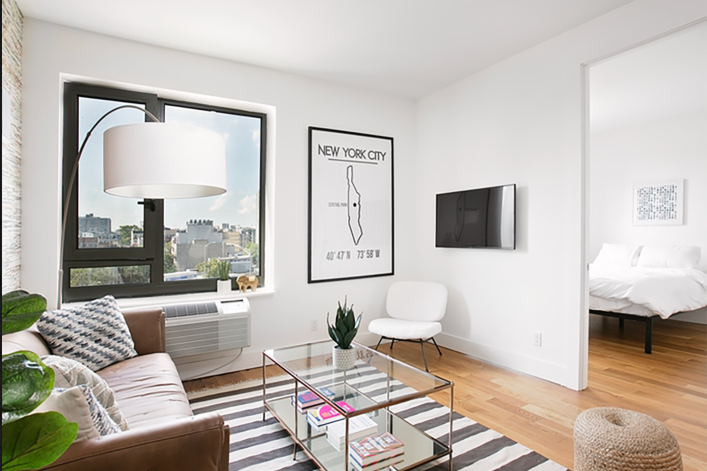What is co-living, and why is it such a big deal?
If you’ve heard the term co-living and dismissed it because you thought it was some millennial fad or just didn’t think it was a big deal, you may be making a mistake.
That’s because co-living, part of the sharing economy like Airbnb and Uber, has the potential to bring some real change to the NYC rental apartment market by putting some downward pressure on prices, at least according to one observer, by capturing a chunk of the rental market.
After gaining a small footprint in the city around 2012 with a handful of companies, about a dozen providers have blossomed in the past two years, with companies like Common, Alta+ by Ollie, and Roomrs launching new locations and looking to dominate the scene. For example: WeLive, an offshoot of WeWork, is looking to expand to 34,000 residents worldwide by the end of the year. (You can compare different kinds of NYC co-living arrangements in our our guide to co-living companies.)
But unlike its industry disruptor cousins Airbnb and Uber, co-living doesn’t face the same level of organized or legislative pushback, at least not yet. More on that in a moment.
But what is it exactly?
Similar to the co-working model of WeWork, which offers office space by the room or even by the desk, co-living brings people who are unrelated together to share apartments, with some important distinctions.
“Co-living is an alternative way of living, enabling strangers to share a home in order to live more affordably and socially,” says Zach Ehrlich, CEO of Stoop, a site that offers furnished listings in NYC. But in case you’re not aware, co-living is much more than just apartment sharing or a rooming house.
Co-living company founders will tell you that they got in the business to make it easier for newcomers to the city to rent an apartment, an experience that typically results in one struggle after another: hunting for a legit apartment, finding a roommate, satisfying income requirements, and securing a guarantor. In exchange for a premium, co-living spaces take most of those annoyances away, and even assumes command of smaller hassles, like splitting bills, keeping common spaces clean, and stocking the apartment with essentials, all included in the monthly rent.
But just as co-living makes securing an apartment easy, it makes leaving one far simpler as well, which is very appealing to people who live a more globe-trotting, nomadic lifestyle for work or fun. Some offer the flexibility to hop from one location to another, or minimum stays as short as 30 days, or even a single night. And then there is the social life that comes with many of these locations: immediate friends, scheduled outings, even managers who check on your sleep quality.
Does it sound too big brother-ish? Too mothering? Smothering? If you think that co-living contributes to delayed adulthood, Ehrlich would argue the opposite: The expense of living in NYC can interfere with hitting major adult milestones at the appropriate times.
“New Yorkers and those in major urban cities are often waiting to make major life commitments such as marriage and having families,” he says. Conversely, you also have “couples deciding to move-in together [as] a function of the extremely high cost of housing and living alone,” he says.
Co-living makes particularly good sense for New York City where you have factors like high costs, limited space, and a desire for people to be in very specific areas to live and socialize, says Jeff Holzmann, managing director of iintoo, a real estate investment company.
But there are plenty of limits on co-living. You can’t just increasingly subdivide rooms (legally, bedrooms need to have a minimum of 80 square feet, and no dimension can be less than 8 feet, according to New York City Building Code). Still, rooms can feel very small, like this three-bedroom co-living micro-suite in Long Island City, which was available earlier this summer for $5,481.
“It won’t solve the residential crunch in NYC, Holzmann says, “But it could reverse the trend of prices only going up. Co-living could make a dent in that trend, since you can take virtually any space and make it a co-living.”
However, Ehrlich says, “many buildings in NYC are simply not optimized for co-living.”
“One of the biggest obstacles to attracting co-living renters is bathroom sharing. I have seen cases in which an apartment is flexed to accommodate four bedrooms with only one bathroom. Tenants with greater financial means will likely opt for their own place.”
Will co-living consolidate?
With at least a dozen co-living companies in New York City, some shakeout is inevitable.
“If you think of the life cycle of every business category, proliferation drives prices down. But there’s a hard floor for costs and a lot of market forces at play,” Holzmann says. “Over time, we’ll start to see consolidation.”
Interestingly, co-living appears to have been spared the legislative opposition faced by Uber and Airbnb. Both of those companies “have struggled with legal histories from day one and invested a lot of time and money fighting with regulators,” says Holzmann, who ticked off an accounting of skirmishes in New York City, San Francisco, Paris, and other cities.
A new signed law earlier this month will require home-sharing companies to give New York City officials detailed information about hosts and their rentals, a move that cramps the industry severely, according to the New York Post. Also this month, Mayor de Blasio approved a cap on the new licenses for Uber and other app-based car services.
Co-living hasn’t been the subject of similar legislation, at least not yet. While Holzmann predicts there are a “slew of issues that will come up to challenge co-living, opposition will be fragmented.”
“Co-living doesn’t have a natural predator,” he says, unlike the hotel industry, which is fighting Airbnb, or the taxi and limousine business, which is fighting to protect itself from Uber and the like.
But despite its popularity, the sharing economy is still bizarre to some people, such as older people like his parents.
“For many people it is unconceivable. It’s crazy to think that some dude is going to come pick you up or you’re going to stay in some stranger’s home,” Holzmann says. But eventually, “it will be second nature to the generation rising.”
A clue to the future of co-living lies in the evolution of Airbnb, which was originally branded as way to get to know a neighborhood through your “host,” Holzmann points out.
“But you don’t want to meet the owner. You don’t even want to talk to your Uber driver. Sure, some people are more social,” but now, he says, these services are viewed differently.
“It’s a commodity. The mindset is: We are sharing resources.”
You Might Also Like































